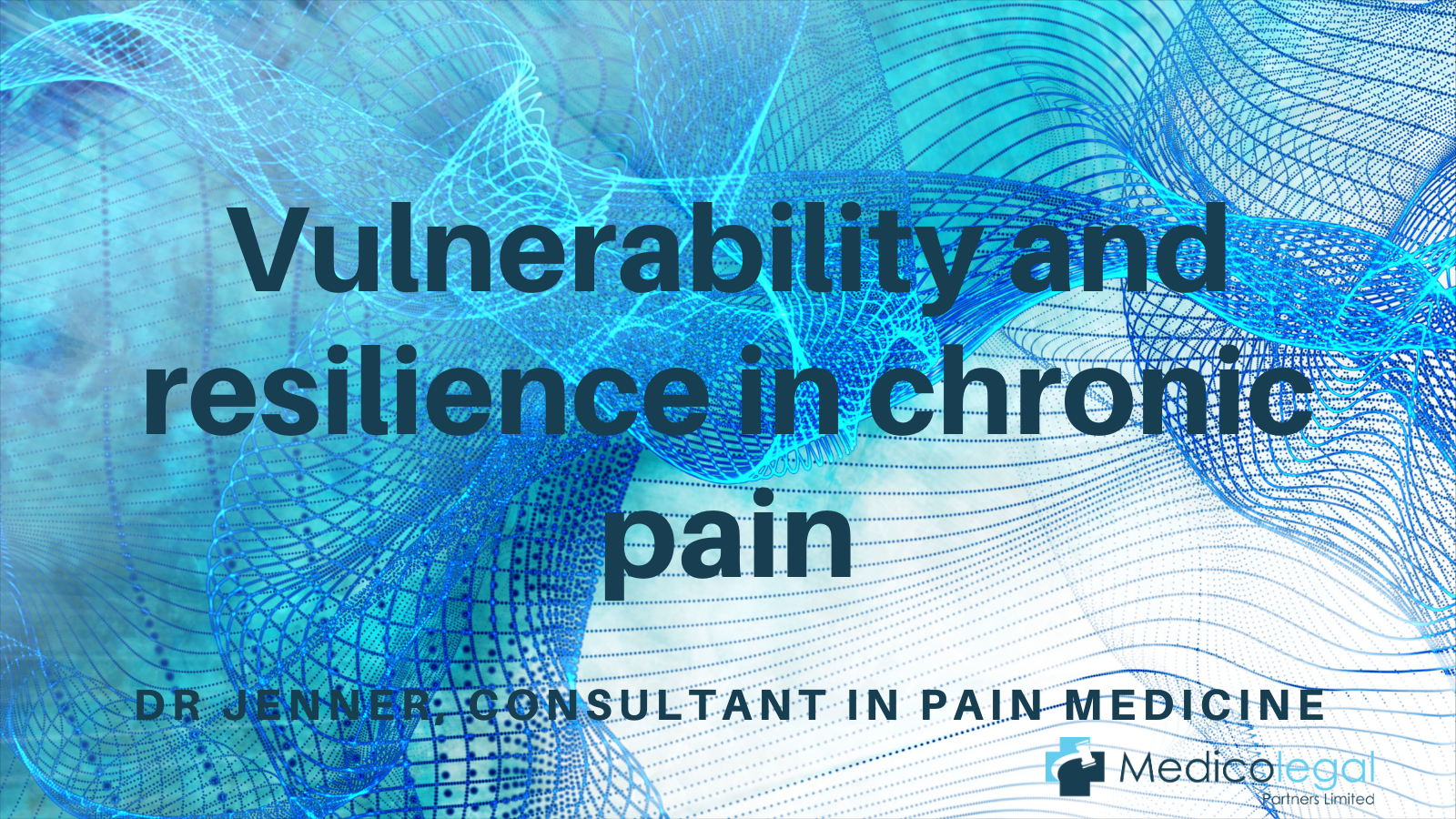Vulnerability and Resilience in Chronic Pain

Pain is the body’s warning system: it tells us that we have sustained an injury and need to heal. In most people, pain is a transient phenomenon, lasting only until the healing process is complete. However, some individuals report pain lasting for weeks, months or even years after the initial injury or accident. This can have serious effects on the person’s functioning, ability to work and social life. Quite why this happens in some people and not others remains an ongoing question. One hypothesis is that certain individuals exhibit a pre-existing psychological vulnerability that predisposes them to developing chronic pain. In this article, Dr Chris Jenner, Consultant in Pain Medicine, explores pre-existing vulnerabilities, psychological and physiological factors, different responses to pain and the treatment of chronic pain.
It is now widely accepted that pain is not a purely physical experience, and there is a psychological element to the way we perceive it. Psychological factors also influence outcomes, particularly quality of life and the extent to which pain interferes with the patient’s daily activities. Two patients with similar injuries can report widely differing levels of pain. This may also explain why, for example, military personnel can suffer catastrophic injuries but experience very little pain. There is a strong association between psychological conditions such as depression, anxiety, substance abuse and post-traumatic stress disorder (PTSD) and chronic pain. Patients with chronic pain and PTSD or depression report worse symptoms than patients suffering from chronic pain alone, suggesting that these conditions work in tandem.
Patients with chronic pain often have other lifestyle issues. These include previous physical or psychological trauma; poor health habits, including poor diet, lack of exercise, smoking and excessive drinking; social isolation and poverty. All of these factors will cause stress. This increases an individual’s general vulnerability to pain, so that when an injury or accident occurs, it can trigger a major response, even if the index incident appears trivial. Furthermore, pre-existing psychological attributes, such as anxiety, are associated with abnormalities in brain chemistry. This disrupts normal emotional control, so that affected individuals are unable to control their distress and become increasingly anxious. In this state, sensitivity to pain is heightened.
Various models have been suggested to explain how psychological factors may influence the development and maintenance of chronic pain. Perhaps the best-known of these is the fear-avoidance model, developed by Vlaeyen and Linton in 2000. This model suggests that some patients may interpret the experience of pain as excessively threatening. This is known as catastrophising, and it has been consistently linked to worse outcomes in studies of chronic pain. Catastrophising not only contributes to a fear of pain but leads to various behaviours designed to avoid pain, such as refusal to participate in activities that may be painful and an excessive awareness of bodily sensations. These may lead to disability and depressive symptoms, which in turn, fuel the individual’s fear and avoidance. Thus, the cycle of pain continues.
A modified version of the fear-avoidance model suggests that physiological symptoms, such as increased heart rate and blood flow, lead to an increase in pain sensations. This serves to reinforce the fear of potentially painful activities to an even greater extent and avoidance behaviour results. In addition, physiological signs such as muscle tension may be misinterpreted as being pain-related. The likelihood of this happening is related to the individual’s propensity to respond to negative sensations with fear. Therefore, physiological reactivity may be related to anxiety, fear and catastrophising.
Conversely, patients who are able to address their pain have a better prognosis for recovery, assuming there is no underlying cause which might restrict them, as they are able to participate more fully in daily activities. These attributes are known collectively as resilience factors. Both vulnerability and resilience factors are associated with pain outcomes, but in opposite directions. In fact, there is some suggestion that they are more important than medical diagnosis and pain intensity combined in determining a patient’s prognosis.
Treatment of chronic pain is challenging. Given the association between resilience factors and positive outcomes in pain prognosis, it makes sense to focus on treatments that strengthen those factors. Some researchers have reported successful outcomes where psychological symptoms were treated in conjunction with the pain. Therapies such as cognitive behavioural therapy, which trains the patient to reframe maladaptive beliefs, as well as teaching coping strategies and relaxation techniques, can be particularly beneficial. As many chronic pain sufferers feel that they have no control over their pain, changing this perception often leads to an improvement in their condition.
There is no empirical test to prove the existence of pre-existing vulnerability to pain. Close examination of the patient’s pre-incident medical history may reveal a pattern of mental health issues and pain episodes that could indicate a possible vulnerability. In such patients, the post-incident history may be equally important. The vulnerability hypothesis suggests that in affected patients, the pre-existing vulnerability would have been triggered sooner or later by a seemingly trivial incident. If a pre-accident condition or injury can be found, it may limit any claim on the grounds that the patient would probably have developed chronic pain from another source relatively soon anyway.
About the fear avoidance model of pain:
About Dr Jenner
His particular areas of expertise include, but are not limited to:
- Neuropathic pain
- Chronic and chronic widespread pain
- Chronic Pain Syndromes
- Complex Regional Pain Syndrome
- Phantom limb pain and Post Mastectomy Pain Syndrome
- Multi-disciplinary pain management
- Fibromyalgia
Further reading:
Alschuler KN, Kratz AL, Ehde DM. Resilience and vulnerability in individuals with chronic pain and physical disability. Rehabil Psychol. 2016 Feb;61(1):7-18. doi: 10.1037/rep0000055. PMID: 26881303; PMCID: PMC4758368.
Vlaeyen JWS, Linton SJ. Fear-avoidance and its consequences in chronic musculoskeletal pain: a state of the art. Pain. 2000 Apr;85(3):317-332. doi: 10.1016/S0304-3959(99)00242-0. PMID: 10781906.
